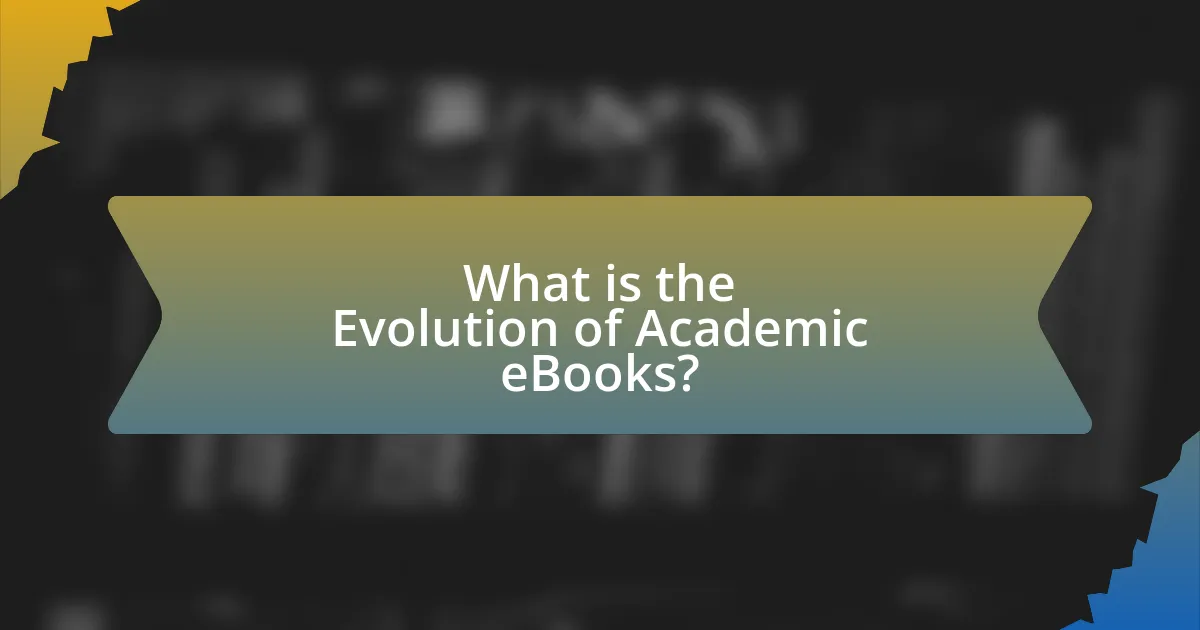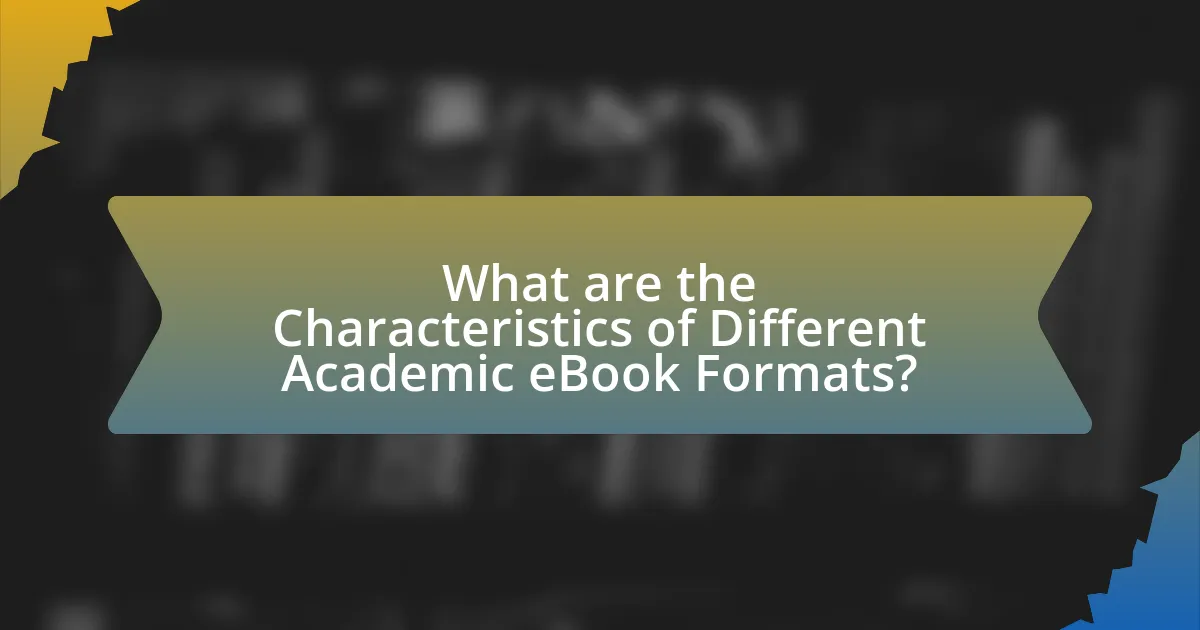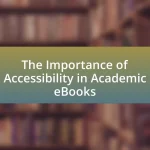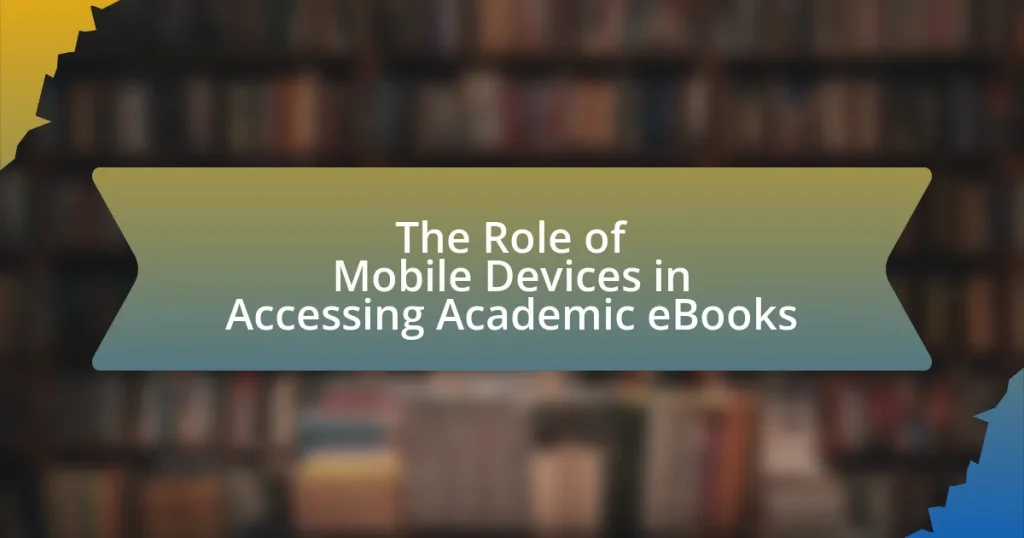The article examines the evolution of academic eBooks, tracing their development from static PDF formats introduced in the late 1990s to the dynamic, interactive formats prevalent today. It highlights key milestones, including the emergence of eBook readers and platforms that enhanced user engagement through features like annotations and multimedia integration. The discussion also covers the limitations of traditional PDF eBooks in academic settings, the rise of interactive formats that improve learning outcomes, and the impact of technological advancements on accessibility and functionality. Additionally, the article addresses the challenges educators face in integrating eBooks into curricula and offers best practices for effective utilization.

What is the Evolution of Academic eBooks?
The evolution of academic eBooks began with the introduction of PDF formats in the late 1990s, which allowed for digital distribution of texts while preserving formatting. As technology advanced, eBooks transitioned to more interactive formats, incorporating multimedia elements and enhanced navigation features. By the early 2010s, platforms like Kindle and iBooks emerged, offering features such as annotations and hyperlinks, which improved user engagement and accessibility. Recent developments include the integration of adaptive learning technologies and interactive simulations, further enriching the academic experience. This progression reflects the ongoing demand for more dynamic and user-friendly educational resources in the digital age.
How have academic eBooks changed over time?
Academic eBooks have evolved significantly from static PDF formats to dynamic, interactive formats. Initially, academic eBooks were primarily distributed as PDFs, which offered limited interactivity and functionality. Over time, advancements in technology have led to the development of eBooks that incorporate multimedia elements, such as videos, interactive quizzes, and hyperlinks, enhancing user engagement and learning experiences. For instance, platforms like VitalSource and ProQuest now provide eBooks that allow for annotations, collaborative features, and adaptive learning tools, reflecting a shift towards more user-centered design in academic publishing. This transformation has been driven by the increasing demand for accessible and interactive educational resources, as evidenced by the rise in digital textbook adoption in higher education, which reached over 30% in recent years.
What were the initial formats of academic eBooks?
The initial formats of academic eBooks were primarily PDF and HTML. PDF, introduced in the early 1990s, provided a consistent layout across different devices, making it a popular choice for academic publications. HTML, which emerged alongside the World Wide Web, allowed for more interactive and hyperlinked content, facilitating easier navigation and access to supplementary materials. These formats laid the groundwork for the subsequent evolution of eBooks, as they addressed the need for digital accessibility and preservation of formatting in academic texts.
How did the introduction of PDF format impact academic eBooks?
The introduction of the PDF format significantly transformed academic eBooks by providing a standardized, portable, and easily accessible way to present scholarly content. This format allowed for consistent formatting across different devices and platforms, ensuring that academic texts maintained their intended layout and design, which is crucial for complex documents like research papers and textbooks. The PDF format also facilitated the inclusion of images, graphs, and tables, enhancing the visual presentation of academic material. Furthermore, the widespread adoption of PDF readers made it easier for students and researchers to access and share academic resources, thereby increasing the dissemination of knowledge within the academic community.
What are the key milestones in the evolution of academic eBooks?
The key milestones in the evolution of academic eBooks include the introduction of the PDF format in the early 1990s, which allowed for digital distribution of texts while preserving formatting. In the late 1990s, the emergence of eBook readers, such as the Rocket eBook and SoftBook, marked a shift towards dedicated devices for reading digital content. The early 2000s saw the rise of platforms like Project Gutenberg, which provided free access to a vast library of texts, further popularizing eBooks in academia. The launch of the Amazon Kindle in 2007 revolutionized the market by integrating wireless access and a vast catalog of academic titles. In the 2010s, the development of interactive eBooks, incorporating multimedia elements and adaptive learning technologies, transformed the academic landscape, enhancing engagement and accessibility for students. These milestones collectively illustrate the significant advancements in the format, accessibility, and functionality of academic eBooks over time.
When did interactive formats begin to emerge in academic eBooks?
Interactive formats began to emerge in academic eBooks around the early 2010s. This shift was driven by advancements in technology and the increasing demand for more engaging and interactive learning experiences. The introduction of HTML5 and enhanced multimedia capabilities allowed publishers to create eBooks that included interactive elements such as quizzes, videos, and animations, significantly enhancing the educational value of digital texts.
What technological advancements have influenced the evolution of academic eBooks?
Technological advancements such as the development of digital publishing platforms, enhanced e-reader devices, and the integration of multimedia content have significantly influenced the evolution of academic eBooks. Digital publishing platforms like Adobe InDesign and Pressbooks have streamlined the creation and distribution of eBooks, allowing for easier formatting and accessibility. Enhanced e-reader devices, including Kindle and tablets, have improved user experience through features like adjustable text size and built-in dictionaries. Furthermore, the integration of multimedia elements, such as videos, interactive quizzes, and hyperlinks, has transformed static texts into dynamic learning tools, fostering greater engagement and interactivity in academic settings. These advancements collectively reflect a shift from traditional PDF formats to more versatile and interactive eBook formats, catering to diverse learning needs.

What are the Characteristics of Different Academic eBook Formats?
Different academic eBook formats exhibit distinct characteristics that cater to various user needs and technological advancements. PDF format is widely used for its fixed layout, ensuring consistent presentation across devices, but lacks interactivity. EPUB format offers reflowable content, allowing for better adaptability on different screen sizes and enabling features like embedded multimedia and hyperlinks. MOBI format, primarily used by Kindle devices, supports annotations and bookmarks but is less flexible than EPUB. Interactive formats, such as HTML5, provide dynamic content, allowing for user engagement through quizzes and multimedia elements, enhancing the learning experience. Each format’s characteristics reflect its intended use, with PDFs prioritizing stability, EPUBs focusing on accessibility, MOBIs catering to specific devices, and interactive formats emphasizing user interaction.
What distinguishes PDF eBooks from interactive formats?
PDF eBooks are primarily static documents, while interactive formats incorporate dynamic elements that enhance user engagement. PDF eBooks present content in a fixed layout, making them suitable for straightforward reading and printing, but lacking features like multimedia integration, hyperlinks, or user interactivity. In contrast, interactive formats allow for multimedia elements such as videos, animations, and quizzes, which facilitate a more immersive learning experience. This distinction is evident in educational contexts where interactive formats have been shown to improve retention and understanding, as supported by research indicating that interactive learning can enhance cognitive engagement compared to traditional reading methods.
How do user experiences differ between PDF and interactive eBooks?
User experiences differ significantly between PDF and interactive eBooks, primarily in terms of engagement and functionality. PDFs provide a static reading experience, limiting user interaction to scrolling and zooming, which can hinder comprehension and retention. In contrast, interactive eBooks offer features such as multimedia elements, hyperlinks, and quizzes, enhancing user engagement and facilitating active learning. Research indicates that interactive formats can improve information retention by up to 30% compared to traditional PDFs, as users are more likely to engage with content that includes interactive elements.
What are the limitations of PDF eBooks in academic settings?
PDF eBooks have several limitations in academic settings, primarily related to accessibility, interactivity, and usability. Firstly, PDF files often lack features that enhance accessibility for individuals with disabilities, such as screen reader compatibility and text-to-speech functionality. According to the World Health Organization, approximately 15% of the world’s population experiences some form of disability, highlighting the importance of accessible formats in education.
Secondly, PDF eBooks typically do not support interactive elements like quizzes, embedded videos, or hyperlinks that can enhance learning experiences. Research from the Journal of Educational Technology & Society indicates that interactive content significantly improves student engagement and retention of information.
Lastly, the static nature of PDFs can hinder effective note-taking and annotation, as many PDF readers do not allow for easy highlighting or commenting. A study published in the International Journal of Educational Research found that students prefer formats that allow for dynamic interaction with the text, which PDFs do not facilitate effectively.
What types of interactive formats are available for academic eBooks?
Interactive formats available for academic eBooks include multimedia elements, quizzes, simulations, and annotation tools. These formats enhance user engagement and facilitate active learning by integrating audio, video, and interactive graphics, which can provide a richer educational experience. For instance, research indicates that eBooks incorporating interactive quizzes can improve retention rates by up to 30%, demonstrating the effectiveness of these formats in educational settings.
What features do interactive eBooks offer that enhance learning?
Interactive eBooks enhance learning through features such as multimedia integration, interactive quizzes, and adaptive learning paths. Multimedia integration allows users to engage with text, audio, and video, catering to different learning styles and improving retention. Interactive quizzes provide immediate feedback, reinforcing knowledge and identifying areas for improvement. Adaptive learning paths personalize the educational experience by adjusting content based on individual progress and performance, which has been shown to increase learner engagement and success rates. These features collectively create a more immersive and effective learning environment compared to traditional formats.
How do multimedia elements contribute to the effectiveness of interactive eBooks?
Multimedia elements enhance the effectiveness of interactive eBooks by engaging users through various formats such as text, audio, video, and interactive graphics. These elements cater to different learning styles, making content more accessible and stimulating. For instance, a study by the University of Southern California found that incorporating multimedia can improve retention rates by up to 60% compared to traditional text-only formats. This engagement not only aids comprehension but also encourages active participation, leading to a more immersive learning experience.

How do Academic eBooks Impact Learning and Teaching?
Academic eBooks significantly enhance learning and teaching by providing interactive and accessible resources that cater to diverse learning styles. These digital formats allow for features such as multimedia integration, searchability, and real-time updates, which traditional print materials cannot offer. Research indicates that students using eBooks demonstrate improved engagement and retention rates; for instance, a study published in the Journal of Educational Technology & Society found that 70% of students preferred eBooks for their interactive elements, which facilitate deeper understanding of complex subjects. Additionally, educators benefit from the ability to easily distribute materials and track student progress through analytics provided by eBook platforms.
What benefits do interactive eBooks provide to students and educators?
Interactive eBooks provide enhanced engagement and personalized learning experiences for students and educators. These digital resources incorporate multimedia elements such as videos, quizzes, and interactive diagrams, which cater to diverse learning styles and improve information retention. Research indicates that interactive content can increase student motivation and participation, leading to better academic outcomes. For instance, a study published in the Journal of Educational Psychology found that students using interactive eBooks scored significantly higher on assessments compared to those using traditional texts. Additionally, educators benefit from real-time analytics that track student progress and understanding, allowing for tailored instruction and timely interventions.
How do interactive eBooks facilitate engagement and retention of information?
Interactive eBooks facilitate engagement and retention of information by incorporating multimedia elements, interactive quizzes, and hyperlinks that enhance the learning experience. These features actively involve readers, making the content more relatable and easier to understand. Research indicates that interactive elements can increase retention rates by up to 60% compared to traditional formats, as they promote active participation and cognitive engagement. For instance, a study published in the Journal of Educational Psychology found that students using interactive eBooks scored significantly higher on retention tests than those using static PDFs, demonstrating the effectiveness of these engaging formats in improving information retention.
What role do academic eBooks play in remote and hybrid learning environments?
Academic eBooks serve as essential resources in remote and hybrid learning environments by providing accessible, interactive, and up-to-date content. They enable students to engage with materials anytime and anywhere, facilitating flexible learning that adapts to individual schedules. Research indicates that 70% of students prefer digital formats for their ease of use and accessibility, which enhances their learning experience. Furthermore, academic eBooks often include features such as hyperlinks, multimedia elements, and interactive quizzes, which promote active learning and retention of information. This adaptability and interactivity make academic eBooks a vital component in modern educational settings, particularly as institutions increasingly embrace digital learning solutions.
What challenges do educators face when integrating eBooks into their curriculum?
Educators face several challenges when integrating eBooks into their curriculum, including technological barriers, accessibility issues, and resistance to change. Technological barriers arise from the need for reliable internet access and compatible devices, which can hinder effective implementation. Accessibility issues often involve ensuring that eBooks are usable for all students, including those with disabilities, which may require additional resources or adaptations. Resistance to change can stem from educators’ familiarity with traditional teaching methods and skepticism about the effectiveness of eBooks compared to printed materials. These challenges are supported by research indicating that 30% of educators report difficulties in accessing necessary technology, while 40% express concerns about the adequacy of eBook formats for diverse learning needs.
How can institutions overcome resistance to adopting eBook technologies?
Institutions can overcome resistance to adopting eBook technologies by implementing comprehensive training programs for faculty and students. These programs should focus on demonstrating the benefits of eBooks, such as enhanced accessibility, interactive features, and cost-effectiveness compared to traditional textbooks. Research indicates that institutions that provide hands-on workshops and ongoing support see a significant increase in eBook adoption rates. For example, a study by the University of North Texas found that after a series of training sessions, eBook usage among students increased by 40%, highlighting the importance of education in easing resistance.
What are the common technical issues associated with academic eBooks?
Common technical issues associated with academic eBooks include compatibility problems, formatting errors, and accessibility challenges. Compatibility issues arise when eBooks do not function properly across different devices or platforms, limiting user access. Formatting errors can lead to misaligned text, broken hyperlinks, or missing images, which detract from the reading experience. Accessibility challenges often involve inadequate support for assistive technologies, making it difficult for users with disabilities to engage with the content. These issues are frequently reported in user feedback and technical support inquiries, highlighting the need for improved standards in eBook development.
What are the best practices for utilizing academic eBooks effectively?
To utilize academic eBooks effectively, users should employ strategies such as leveraging search functions, bookmarking important sections, and utilizing annotation tools. These practices enhance navigation and comprehension, allowing users to quickly locate relevant information and engage with the content more deeply. Research indicates that interactive features in eBooks, such as hyperlinks and multimedia elements, can significantly improve learning outcomes by providing diverse ways to access and understand material. For instance, a study published in the Journal of Educational Technology found that students who used interactive eBooks scored 20% higher on comprehension tests compared to those using traditional formats.
How can educators select the right eBook format for their courses?
Educators can select the right eBook format for their courses by assessing the specific needs of their curriculum and the technological capabilities of their students. Factors to consider include the interactivity required, compatibility with devices, and accessibility features. For instance, formats like EPUB and MOBI support reflowable text and multimedia elements, enhancing engagement, while PDF is suitable for static content. Research indicates that 70% of students prefer interactive eBooks for their ability to integrate quizzes and videos, which can improve learning outcomes. Therefore, aligning the eBook format with educational goals and student preferences is crucial for effective course delivery.
What strategies can enhance the use of interactive eBooks in teaching?
Integrating multimedia elements, such as videos and interactive quizzes, can significantly enhance the use of interactive eBooks in teaching. These elements engage students more effectively than traditional text, fostering deeper understanding and retention of material. Research indicates that interactive content can increase student engagement by up to 60%, as shown in a study by the University of California, which found that students using interactive eBooks scored 20% higher on assessments compared to those using static formats. Additionally, incorporating collaborative features, such as discussion forums and shared annotations, encourages peer interaction and enhances the learning experience.














